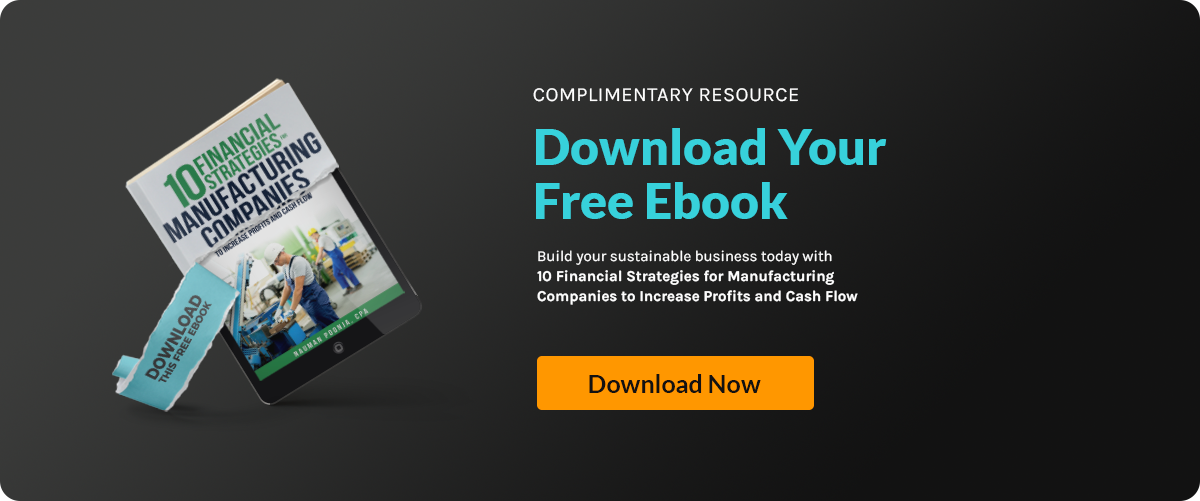Manufacturing owners live in a world of thin margins, tight schedules, and nonstop decisions about...
FIFO vs. LIFO vs. Average Cost: Inventory Valuation Methods for Manufacturers

Inventory valuation isn’t just bookkeeping. It affects your taxes, profits, and how investors see your company. For manufacturing companies where inventory often makes up a significant portion of the balance sheet, choosing the right method matters.
What Is Inventory Valuation?
Inventory valuation is the method used to assign costs to inventory at the end of an accounting period. This cost directly impacts your cost of goods sold (COGS), gross profit, net income, and taxes.
The three most common methods used by manufacturers are:
-
FIFO (First-In, First-Out)
-
LIFO (Last-In, First-Out)
-
Average Cost Method
What Are FIFO and LIFO?
FIFO (First In, First Out)
FIFO assumes that the oldest inventory items are sold first. In other words, the first items you put into inventory are the first ones you take out.
Advantages:
- Higher profit during inflationary periods
- Higher inventory valuation on the balance sheet
- Easier to match physical flow of goods
Disadvantages:
-
Higher taxable income in rising price environments
Best for: Food, pharmaceutical, or electronics manufacturers where items lose value over time.
LIFO (Last In, First Out)
LIFO assumes that the newest inventory items are sold first. So the most recent costs are recognized first in COGS.
Advantages:
- Lower tax liability in inflationary periods
- Better matching of current costs with current revenues
Disadvantages:
- Lower reported profits
- Lower inventory value on the balance sheet
- Not allowed under IFRS (International Financial Reporting Standards)
Best for: Manufacturers dealing with volatile input prices (metals, petroleum, chemicals).
FIFO vs. LIFO: A Side-by-Side Comparison
|
Factor |
FIFO |
LIFO |
|
Inventory Cost Flow Assumption |
Oldest inventory sold first |
Newest inventory sold first |
|
COGS Impact |
Lower COGS (in inflation) |
Higher COGS (in inflation) |
|
Net Income |
Higher |
Lower |
|
Tax Liability |
Higher |
Lower |
|
Ending Inventory Value |
Higher |
Lower |
|
Financial Reporting |
Common under IFRS and GAAP |
Allowed only under U.S. GAAP |
Average Cost (Weighted Average)
The Average Cost method spreads total inventory costs evenly across all units. Every item is assigned the same average cost regardless of when it was purchased or produced.
Formula:
Average Unit Cost = Total Cost of Inventory ÷ Total Units Available
Advantages:
- Smooths out price fluctuations
- Easier to manage in systems with high inventory volume
Disadvantages:
- May not reflect real-time cost trends
- Can understate or overstate COGS depending on timing
Best for: Blended or batch manufacturing (plastics, textiles, chemicals).
Why It Matters for Manufacturing Businesses
In manufacturing, small changes in cost flow assumptions can ripple across your entire financial picture. If you're not aligning your inventory method with your business strategy, you may be under- or over-reporting profits—and affecting everything from loan covenants to tax planning.
FIFO is often a better fit for companies with fast-moving inventory and rising prices. It keeps inventory values more reflective of current costs and gives a healthier-looking bottom line.
LIFO may be preferred when reducing tax burden is a bigger priority than financial optics. It’s also useful in volatile material cost environments where replacement costs fluctuate sharply.
Choosing the right method helps improve clarity on cost of goods sold, plan around profit margins, and align your reporting with strategic forecasting.
How Each Method Affects Your Profit and Taxes
Each method impacts:
- COGS (affects gross margin)
- Ending Inventory (affects current assets on balance sheet)
- Net Income (affects retained earnings)
For instance, FIFO may lead to higher reported net income, which boosts your top line—but also raises your tax bill. On the other hand, LIFO could reduce net income but preserve cash flow.
Learn more about top line vs. bottom line impacts in your financial reports.
GAAP vs. IFRS Compliance
- LIFO is allowed under U.S. GAAP, but not under IFRS.
- Companies with international operations or subsidiaries may not be able to use LIFO universally.
Manufacturers exporting to other countries or operating globally must keep this in mind when standardizing accounting practices.
Read: What is GAAP and Why is it Needed
Inventory Turns and Operational Metrics
Inventory valuation methods don’t just affect taxes—they shape your operational metrics too.
- FIFO generally shows higher inventory turnover ratios, suggesting better efficiency.
- LIFO can suppress turnover ratios, making performance seem slower on paper.
- Average Cost provides more stable ratios but less granularity.
For strategic insights, see: Margin Analysis in Manufacturing and Capacity & Production Planning.
Changing Methods: IRS Form 3115
Switching inventory methods isn’t just a preference—it requires IRS approval.
- Use Form 3115 to request a change in accounting method.
- Once you start using LIFO, you can’t switch without IRS approval
- Changes can have big tax consequences, so consult a CPA.
Considering a switch? Read: How Much Does Bookkeeping Cost for Manufacturers
Not Sure Which Method to Choose? Start Here
| Inventory Method | Best For |
| FIFO | High-turnover goods, predictable pricing |
| LIFO | High inflation materials, tax-conscious strategy |
| Average Cost | Large batch production, blended or mixed inputs |
Here’s a quick decision framework:
Consider FIFO if:
- You want clean, globally accepted reporting
- You operate under IFRS or GAAP and need consistency
- Your prices are stable or declining
- You're prioritizing investor/lender confidence
Consider LIFO if:
- Your material costs are rising
- You want to reduce current-year tax liability
- You operate under U.S. GAAP
- You’re optimizing for cash flow instead of net income
Consider Average Cost if:
-
Your business involves high-volume batch production
-
You blend raw materials and can’t easily separate inventory layers
-
You want a simplified, consistent costing method
-
You use ERP systems or inventory software that calculates average cost automatically
-
You’re prioritizing ease of recordkeeping and reporting over tax optimization
Remember—once you choose, switching methods isn’t easy. The IRS requires approval for changes, and consistency is expected year over year.
Final Thoughts
Inventory valuation methods are more than a technicality—they influence everything from tax strategy to performance metrics. Whether you choose FIFO, LIFO, or Average Cost, the key is consistency and alignment with your operational goals.
Need help optimizing your inventory accounting strategy? Schedule a strategy session with Accounovation to determine the best-fit method for your business.







